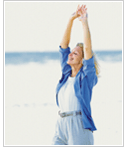 |
 |
 |
 |
 |
|
|
 |
   

|
 |


Flexibility Lowers Arthritis Risk in Older Women
By Stephanie Riesenman
NEW YORK (Reuters Health) - Older women who are "double-jointed" -- or those who have super-flexible joints -- are less likely to have arthritic knees than their peers, according to a study of British women.
It's not clear from the study if women were born with extra-flexible joints or obtained them through a lifetime of exercise and stretching, according to Tim Spector, a professor of rheumatology at St. Thomas' Hospital in London.
However, the findings suggest the retaining flexibility in old age can ward off arthritis, he told Reuters Health.
"Our research suggests that both the innate or the exercise route (to flexibility) both seem to help prevent arthritis -- so exercise and stretching should be encouraged," said Spector.
"In our study we only tested the women once and can't really separate hypermobile women who remained flexible from normal women who exercised and stretched to become more flexible than their sedentary peers," said Spector.
People with hypermobile joints, as it's known medically, have an expanded range of motion. They can often pull their thumbs down to touch their wrists and have elbows that hyper-extend when they stretch out their arms. And the knees of double-jointed people may
bow backwards when they stand up straight.
It's the looseness of the structures surrounding the joint
that allow it to have more motion, similar to a hinge on a
door that allows it to swing open and closed.
In some cases, hypermobility is a sign of inherited connective tissue or bone disease, and some studies had suggested it might actually increase the risk of osteoarthritis. Osteoarthritis occurs when the cartilage that cushions joints breaks down, often leading
to pain, swelling and loss of mobility.
In a study of 716 women in England, 79 had some degree of joint hypermobility, a proportion consistent with the overall population. Most of these women showed increased flexibility in the spinal region and hip joints -- allowing them to easily bend at the waist
and place their hands flat on the floor.
The women, ages 53 to 72, were part of the Chingford Study in London. In the ongoing study, predominantly middle-class white women have received regular x-rays and bone mineral density measurements since 1988.
Spector and his colleagues found that bone mineral density was three percent higher in the hips of the hypermobile group compared with other women. There was no difference in spine bone mineral density between the two groups of women, according to the study in
the current issue of the Journal of Rheumatology.
The researchers also looked for osteoarthritis in the hands, knees, spine and hips of hypermobile women. Compared to their normal-jointed counterparts, hypermobile women showed a reduced risk for arthritis in the knees only.
People born with looser joints may be drawn to physical activity, which may also play a role in arthritis risk, according to Spector.
Women who were taller and more hypermobile in the study were also more physically active throughout their lifetimes. Spector says that may explain the differences in bone mineral density and arthritis between the hypermobile women and those with less flexible
joints.
" We can't prove it -- as it's a chicken and egg situation -- but our data certainly strongly suggest an effect that may be related to fitness and flexibility, rather than exercise per se," he said.
This means that hypermobility in an aging population may be an advantage and a marker of fitness when it persists later in life.
Spector recommends that all postmenopausal women concentrate on flexibility, exercise regularly and keep their body mass index -- a ratio of weight to height -- below 25. He says all these can help prevent
osteoarthritis.
The American Academy of Orthopedic Surgeons and the American Geriatrics Society recommend that adults engage in 30 minutes of moderate physical activity every day. In addition to the cardiovascular benefits, they say exercise strengthens bones and reduces joint
and muscle pain.
SOURCE: The Journal of Rheumatology 2003;30:799-803.
[ back to top ]
|
|
|
|




